Investigation of Flow Fields Emanating from Two Parallel Inlet Valves Using LES, PIV, and POD
Abstract
:1. Introduction
1.1. Motivation
1.2. State-of-the-Art
1.3. Objectives and Content
2. Fundamentals
2.1. Turbulent Flows
2.2. Reynolds Stress Transport Equation
- : The rate of change in specific Reynolds stress in the control volume;
- : The convective flux over the surfaces of the control volume;
- : The diffusive flux owing to molecular transport;
- : The diffusive flux owing to turbulent transport;
- : The diffusive flux owing to pressure/velocity fluctuations;
- : The production term of the specific Reynolds stress;
- : The pressure–strain correlation;
- : The dissipation rate of the specific Reynolds stress.
2.3. Proper Orthogonal Decomposition (POD)
2.3.1. The Direct POD Method
2.3.2. The Snapshot POD Method
2.4. POD Quadruple Decomposition
3. Methodology
3.1. Experimental Facility
3.2. Optical Techniques and Image Processing
4. LES Model Description
5. Results and Discussion
5.1. Flow Behaviour for the Different Operating Points
5.2. Validation of the LES
5.3. Flow Analysis by LES

5.4. Proper Orthogonal Decomposition (POD) of PIV Measurements and Turbulent Structures
5.5. Reynolds Stress Transport at 79.3 kg/h and 4 mm
6. Conclusions and Outlook
6.1. Conclusions
6.1.1. Flow Behaviour Depending on the Mass Flow Rate and the Valve Lift
6.1.2. Structures and Turbulent Kinetic Energy
6.1.3. Reynolds Stress Transport Equation
6.2. Outlook
Author Contributions
Funding
Data Availability Statement
Acknowledgments
Conflicts of Interest
Nomenclature
| Symbol | Unit | Description |
| Dimensionless numbers | ||
| Convective Courant–Friedrichs–Lewy number | ||
| Relevance index | ||
| Skewness coefficient | ||
| Flatness (kurtosis) coefficient | ||
| Dimensionless wall coordinate | ||
| Latin letters | ||
| m s−1 | Matrix containing random time coefficients of the POD modes | |
| m s−1 | Random time coefficients of the POD modes | |
| m2 s−2 | Covariance matrix | |
| m2 s−3 | Convective flux of specific Reynolds stress over the surfaces of the control volume | |
| m2 s−3 | Diffusive flux of specific Reynolds stress due to molecular transport | |
| m2 s−3 | Diffusive flux of specific Reynolds stress due to pressure/velocity fluctuations | |
| m2 s−3 | Diffusive flux of specific Reynolds stress due to turbulent transport | |
| m2 s−3 | Dissipation rate of specific Reynolds stress | |
| m | Focal length | |
| m | Valve lift (identical for both valves) | |
| Loop variable for spatial directions or times | ||
| Loop variable for spatial directions or spaces | ||
| Total number of instant times | ||
| kg s−1 | Mass flow rate | |
| Total number of velocity vectors (data points) | ||
| Pa | Pressure | |
| m2 s−3 | Production term of specific Reynolds stress | |
| m2 s−3 | Rate of change in specific Reynolds stress in the control volume | |
| s | Time | |
| m2 s−2 | Turbulent kinetic energy | |
| K | Temperature | |
| m s−1 | Velocity | |
| m s−1 | Snapshot matrix obtained from the direct POD method containing all velocity fluctuations | |
| m s−1 | Snapshot matrix obtained from the snapshot POD method | |
| m | Cartesian coordinate | |
| m | Cartesian coordinate | |
| m | Cartesian coordinate | |
| Greek letters | ||
| m2 s−2 | Eigenvalues (direct POD method) | |
| m2 s−2 | Eigenvalues (snapshot POD method) | |
| m2 s−1 | Kinematic viscosity | |
| m2 s−3 | Pressure–strain correlation of specific Reynolds stress | |
| kg m−3 | Density | |
| kg m−1 s−2 | Reynolds-stress tensor | |
| Spatial modes of the direct POD method | ||
| Spatial modes of the snapshot POD method | ||
| Subscripts, superscripts, etc. | ||
| Property corresponding to the coherent structures | ||
| Property corresponding to the dominant structures | ||
| Property component in the -direction | ||
| Property at the inlet | ||
| Initial property | ||
| Property at the outlet | ||
| Property corresponding to the turbulent structures | ||
| Vectorial property | ||
| Time-/ensemble-averaged property | ||
| Fluctuating component of property | ||
Abbreviations
| AF | Autofocus |
| BSFC | Brake-specific fuel consumption |
| CAD | Computer-aided design |
| CCD | Charge-coupled device |
| CCV | Cycle-to-cycle variations |
| CFD | Computational fluid dynamics |
| CFL | Courant–Friedrichs–Lewy stability condition |
| COV-IMEP | Coefficient of variation of the indicated mean effective pressure |
| DES | Detached eddy simulation |
| DNS | Direct numerical simulation |
| EGR | Exhaust gas recirculation |
| Flex-OeCos | Test engine with Flexibility regarding Optical engine Combustion diagnostics and/or the development of corresponding Sensing devices and applications. |
| GDI | Gasoline Direct Injection |
| ICE | Internal combustion engine |
| ITFE | Institute of Thermal and Fluid Engineering |
| LASER | Light amplification by stimulated emission of radiation |
| LDA | Laser Doppler anemometry |
| LES | Large eddy simulation |
| Nd:YAG | Neodymium-doped yttrium aluminum garnet |
| MRV | Magnetic resonance velocimetry |
| P1 | Pressure measurement in the intake pipes |
| P2 | Pressure measurement downstream of the optical chamber |
| P3 | Pressure measurement at the outlet |
| P&ID | Piping and instrumentation diagram |
| PISO | Pressure-implicit split operator |
| PX | Pixel |
| SCE | Single cylinder engine |
| SOR | Successive over-relaxation |
| T1 | Temperature measurement in the intake pipes |
| T2 | Temperature measurement downstream of the optical chamber |
| T3 | Temperature measurement at the outlet |
| TME | Thermodynamics of mobile energy conversion systems |
| OTB | Optical test bench |
| OP | Operating point |
| PIV | Particle image velocimetry |
| POD | Proper orthogonal decomposition |
| RANS | Reynolds-averaged Navier–Stokes |
Appendix A
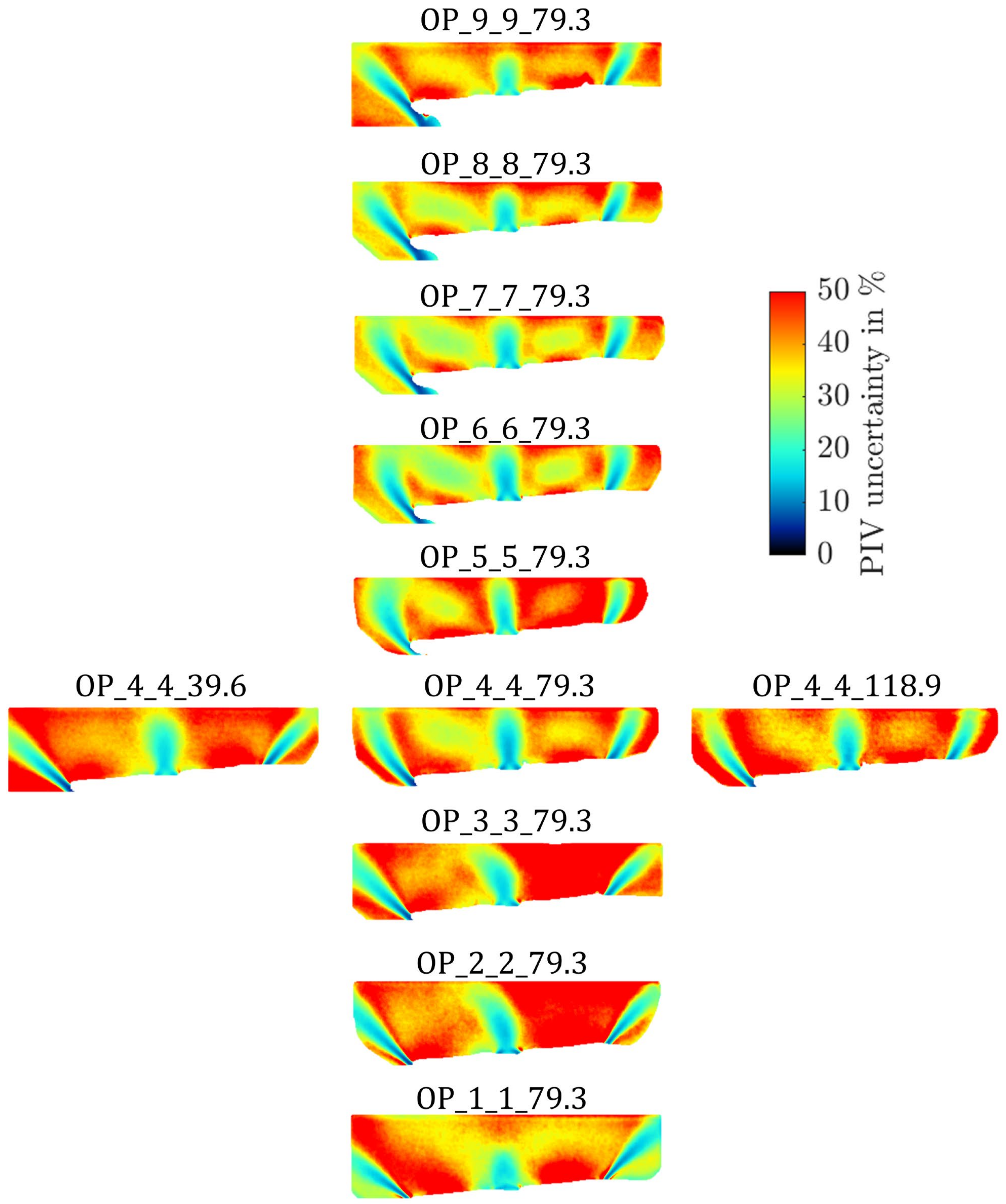
| Measurement | Measuring Device | Range | Uncertainty |
|---|---|---|---|
| Pressures P1, P2, P3 | PD-39S/1178 | 0.1% full scale max | |
| Mass flow rate | Endress + Hauser Promass 63 F DN8 | of the measurement | |
| Temperatures T1, T2, T3 | Thermocouple Type K |
References
- Reitz, R.D.; Ogawa, H.; Payri, R.; Fansler, T.; Kokjohn, S.; Moriyoshi, Y.; Agarwal, A.; Arcoumanis, D.; Assanis, D.; Bae, C.; et al. IJER editorial: The future of the internal combustion engine. Int. J. Engine Res. 2020, 21, 3–10. [Google Scholar] [CrossRef]
- International Energy Agency (IEA). World Energy Outlook 2019. Available online: https://www.iea.org/reports/world-energy-outlook-2019 (accessed on 21 June 2023).
- Karwade, A.; Thombre, S. Implementation of thermal and fuel stratification strategies to extend the load limit of HCCI engine. J. Therm. Sci. Technol. 2019, 14, JTST0020. [Google Scholar] [CrossRef]
- Young, M.B. Cyclic Dispersion–Some Quantitative Cause-and-Effect Relationships; SAE International: Warrendale, PA, USA, 1980. [Google Scholar] [CrossRef]
- Young, M.B. Cyclic Dispersion in the Homogeneous-Charge Spark-Ignition Engine—A Literature Survey; SAE International: Warrendale, PA, USA, 1981. [Google Scholar] [CrossRef]
- Ozdor, N.; Dulger, M.; Sher, E. Cyclic Variability in Spark Ignition Engines a Literature Survey; SAE International: Warrendale, PA, USA, 1994. [Google Scholar] [CrossRef]
- Ozdor, N.; Dulger, M.; Sher, E. An Experimental Study of the Cyclic Variability in Spark Ignition Engines; SAE International: Warrendale, PA, USA, 1996. [Google Scholar] [CrossRef]
- Ball, J.K.; Raine, R.R.; Stone, C.R. Combustion analysis and cycle-by-cycle variations in spark ignition engine combustion Part 2: A new parameter for completeness of combustion and its use in modelling cycle-by-cycle variations in combustion. Proc. Inst. Mech. Eng. Part D J. Automob. Eng. 1998, 212, 507–523. [Google Scholar] [CrossRef]
- Galloni, E. Analyses about parameters that affect cyclic variation in a spark ignition engine. Appl. Therm. Eng. 2009, 29, 1131–1137. [Google Scholar] [CrossRef]
- Granet, V.; Vermorel, O.; Lacour, C.; Enaux, B.; Dugué, V.; Poinsot, T. Large-Eddy Simulation and experimental study of cycle-to-cycle variations of stable and unstable operating points in a spark ignition engine. Combust. Flame 2012, 159, 1562–1575. [Google Scholar] [CrossRef]
- Urushihara, T.; Murayama, T.; Takagi, Y.; Lee, K.-H. Turbulence and Cycle-by-Cycle Variation of Mean Velocity Generated by Swirl and Tumble Flow and Their Effects on Combustion; SAE International: Warrendale, PA, USA, 1995. [Google Scholar] [CrossRef]
- Stiehl, R.; Bode, J.; Schorr, J.; Krüger, C.; Dreizler, A.; Böhm, B. Influence of intake geometry variations on in-cylinder flow and flow–spray interactions in a stratified direct-injection spark-ignition engine captured by time-resolved particle image velocimetry. Int. J. Engine Res. 2016, 17, 983–997. [Google Scholar] [CrossRef]
- Bode, J.; Schorr, J.; Krüger, C.; Dreizler, A.; Böhm, B. Influence of three-dimensional in-cylinder flows on cycle-to-cycle variations in a fired stratified DISI engine measured by time-resolved dual-plane PIV. Proc. Combust. Inst. 2017, 36, 3477–3485. [Google Scholar] [CrossRef]
- Bode, J.; Schorr, J.; Krüger, C.; Dreizler, A.; Böhm, B. Influence of the in-cylinder flow on cycle-to-cycle variations in lean combustion DISI engines measured by high-speed scanning-PIV. Proc. Combust. Inst. 2019, 37, 4929–4936. [Google Scholar] [CrossRef]
- Hasse, C. Scale-resolving simulations in engine combustion process design based on a systematic approach for model development. Int. J. Engine Res. 2016, 17, 44–62. [Google Scholar] [CrossRef]
- Fischer, J.; Kettner, M.; Spicher, U.; Velji, A. Zylinderinnenströmung und zyklische Schwankungen bei Benzin-Direkteinspritzung. MTZ-Mot. Z. 2005, 66, 202–209. [Google Scholar] [CrossRef]
- Heywood, J.B. Internal Combustion Engine Fundamentals, 2nd ed.; McGraw-Hill Education: New York, NY, USA, 2018; Available online: https://www.accessengineeringlibrary.com/content/book/9781260116106 (accessed on 12 March 2023).
- Huang, R.F.; Lin, K.H.; Yeh, C.-N.; Lan, J. In-cylinder tumble flows and performance of a motorcycle engine with circular and elliptic intake ports. Exp. Fluids 2009, 46, 165–179. [Google Scholar] [CrossRef]
- Kapitza, L.; Imberdis, O.; Bensler, H.P.; Willand, J.; Thévenin, D. An experimental analysis of the turbulent structures generated by the intake port of a DISI-engine. Exp. Fluids 2010, 48, 265–280. [Google Scholar] [CrossRef]
- Bari, S.; Saad, I. CFD modelling of the effect of guide vane swirl and tumble device to generate better in-cylinder air flow in a CI engine fuelled by biodiesel. Comput. Fluids 2013, 84, 262–269. [Google Scholar] [CrossRef]
- Wang, T.; Li, W.; Jia, M.; Liu, D.; Qin, W.; Zhang, X. Large-eddy simulation of in-cylinder flow in a DISI engine with charge motion control valve: Proper orthogonal decomposition analysis and cyclic variation. Appl. Therm. Eng. 2015, 75, 561–574. [Google Scholar] [CrossRef]
- Krishna, A.S.; Mallikarjuna, J.M.; Kumar, D. Effect of engine parameters on in-cylinder flows in a two-stroke gasoline direct injection engine. Appl. Energy 2016, 176, 282–294. [Google Scholar] [CrossRef]
- Yang, J.; Dong, X.; Wu, Q.; Xu, M. Effects of enhanced tumble ratios on the in-cylinder performance of a gasoline direct injection optical engine. Appl. Energy 2019, 236, 137–146. [Google Scholar] [CrossRef]
- Ramajo, D.; Zanotti, A.; Nigro, N. In-cylinder flow control in a four-valve spark ignition engine: Numerical and experimental steady rig tests. Proc. Inst. Mech. Eng. Part D J. Automob. Eng. 2011, 225, 813–828. [Google Scholar] [CrossRef]
- Vu, T.-T.; Guibert, P. Proper orthogonal decomposition analysis for cycle-to-cycle variations of engine flow. Effect of a control device in an inlet pipe. Exp. Fluids 2012, 52, 1519–1532. [Google Scholar] [CrossRef]
- Jemni, M.A.; Kantchev, G.; Abid, M.S. Influence of intake manifold design on in-cylinder flow and engine performances in a bus diesel engine converted to LPG gas fuelled, using CFD analyses and experimental investigations. Energy 2011, 36, 2701–2715. [Google Scholar] [CrossRef]
- Agarwal, A.K.; Gadekar, S.; Singh, A.P. In-cylinder air-flow characteristics of different intake port geometries using tomographic PIV. Phys. Fluids 2017, 29, 95104. [Google Scholar] [CrossRef]
- Lumley, J.L. Early Work on Fluid Mechanics in the IC Engine. Annu. Rev. Fluid Mech. 2001, 33, 319–338. [Google Scholar] [CrossRef]
- Perini, F.; Miles, P.C.; Reitz, R.D. A comprehensive modeling study of in-cylinder fluid flows in a high-swirl, light-duty optical diesel engine. Comput. Fluids 2014, 105, 113–124. [Google Scholar] [CrossRef]
- Clark, L.G.; Kook, S.; Chan, Q.N.; Hawkes, E. The Effect of Fuel-Injection Timing on In-cylinder Flow and Combustion Performance in a Spark-Ignition Direct-Injection (SIDI) Engine Using Particle Image Velocimetry (PIV). Flow Turbul. Combust. 2018, 101, 191–218. [Google Scholar] [CrossRef]
- Krishna, B.M.; Mallikarjuna, J.M. Comparative study of in-cylinder tumble flows in an internal combustion engine using different piston shapes—An insight using particle image velocimetry. Exp. Fluids 2010, 48, 863–874. [Google Scholar] [CrossRef]
- Harshavardhan, B.; Mallikarjuna, J.M. Effect of piston shape on in-cylinder flows and air-fuel interaction in a direct injection spark ignition engine—A CFD analysis. Energy 2015, 81, 361–372. [Google Scholar] [CrossRef]
- Liu, K.; Haworth, D.C. Large-Eddy Simulation for an Axisymmetric Piston-Cylinder Assembly with and without Swirl. Flow Turbul. Combust. 2010, 85, 279–307. [Google Scholar] [CrossRef]
- Rabault, J.; Vernet, J.A.; Lindgren, B.; Alfredsson, P.H. A study using PIV of the intake flow in a diesel engine cylinder. Int. J. Heat Fluid Flow 2016, 62, 56–67. [Google Scholar] [CrossRef]
- El-Adawy, M.; Heikal, M.R.; Aziz, A.R.A.; Siddiqui, M.I.; Wahhab, H.A.A. Experimental study on an IC engine in-cylinder flow using different steady-state flow benches. Alex. Eng. J. 2017, 56, 727–736. [Google Scholar] [CrossRef]
- Liu, D.; Wang, T.; Jia, M.; Wang, G. Cycle-to-cycle variation analysis of in-cylinder flow in a gasoline engine with variable valve lift. Exp. Fluids 2012, 53, 585–602. [Google Scholar] [CrossRef]
- Clenci, A.C.; Iorga-Simăn, V.; Deligant, M.; Podevin, P.; Descombes, G.; Niculescu, R. A CFD (computational fluid dynamics) study on the effects of operating an engine with low intake valve lift at idle corresponding speed. Energy 2014, 71, 202–217. [Google Scholar] [CrossRef]
- Wang, T.; Liu, D.; Tan, B.; Wang, G.; Peng, Z. An Investigation into In-Cylinder Tumble Flow Characteristics with Variable Valve Lift in a Gasoline Engine. Flow Turbul. Combust. 2015, 94, 285–304. [Google Scholar] [CrossRef]
- Borée, J.; Miles, P.C. In-Cylinder Flow. In Encyclopedia of Automotive Engineering; John Wiley & Sons, Ltd.: Chichester, UK, 2014; pp. 1–31. [Google Scholar] [CrossRef]
- Vester, A.K.; Nishio, Y.; Alfredsson, P.H. Investigating swirl and tumble using two prototype inlet port designs by means of multi-planar PIV. Int. J. Heat Fluid Flow 2019, 75, 61–76. [Google Scholar] [CrossRef]
- Vermorel, O.; Richard, S.; Colin, O.; Angelberger, C.; Benkenida, A.; Veynante, D. Towards the understanding of cyclic variability in a spark ignited engine using multi-cycle LES. Combust. Flame 2009, 156, 1525–1541. [Google Scholar] [CrossRef]
- Liu, K.; Haworth, D.C.; Yang, X.; Gopalakrishnan, V. Large-eddy Simulation of Motored Flow in a Two-valve Piston Engine: POD Analysis and Cycle-to-cycle Variations. Flow Turbul. Combust. 2013, 91, 373–403. [Google Scholar] [CrossRef]
- Chen, C.; Ameen, M.M.; Wei, H.; Iyer, C.; Ting, F.; Vanderwege, B.; Som, S. LES Analysis on Cycle-to-Cycle Variation of Combustion Process in a DISI Engine; SAE International: Warrendale, PA, USA, 2019. [Google Scholar] [CrossRef]
- Corcione, F.E.; Valentino, G. Analysis of in-cylinder flow processes by LDA. Combust. Flame 1994, 99, 387–394. [Google Scholar] [CrossRef]
- Chan, V.S.S.; Turner, J.T. Velocity measurement inside a motored internal combustion engine using three-component laser Doppler anemometry. Opt. Laser Technol. 2000, 32, 557–566. [Google Scholar] [CrossRef]
- Janas, P.; Wlokas, I.; Böhm, B.; Kempf, A. On the Evolution of the Flow Field in a Spark Ignition Engine. Flow Turbul. Combust. 2017, 98, 237–264. [Google Scholar] [CrossRef]
- Freudenhammer, D.; Baum, E.; Peterson, B.; Böhm, B.; Jung, B.; Grundmann, S. Volumetric intake flow measurements of an IC engine using magnetic resonance velocimetry. Exp. Fluids 2014, 55, 1724. [Google Scholar] [CrossRef]
- El-Adawy, M.; Heikal, M.R.; Aziz, A.R.A.; Adam, I.K.; Ismael, M.A.; Babiker, M.E.; Baharom, M.B.; Firmansyah; Abidin, E.Z.Z. On the Application of Proper Orthogonal Decomposition (POD) for In-Cylinder Flow Analysis. Energies 2018, 11, 2261. [Google Scholar] [CrossRef]
- Bücker, I.; Karhoff, D.-C.; Klaas, M.; Schröder, W. Stereoscopic multi-planar PIV measurements of in-cylinder tumbling flow. Exp. Fluids 2012, 53, 1993–2009. [Google Scholar] [CrossRef]
- Baum, E.; Peterson, B.; Surmann, C.; Michaelis, D.; Böhm, B.; Dreizler, A. Investigation of the 3D flow field in an IC engine using tomographic PIV. Proc. Combust. Inst. 2013, 34, 2903–2910. [Google Scholar] [CrossRef]
- Cao, J.; Ma, Z.; Li, X.; Xu, M. 3D proper orthogonal decomposition analysis of engine in-cylinder velocity fields. Meas. Sci. Technol. 2019, 30, 85304. [Google Scholar] [CrossRef]
- Enaux, B.; Granet, V.; Vermorel, O.; Lacour, C.; Pera, C.; Angelberger, C.; Poinsot, T. LES study of cycle-to-cycle variations in a spark ignition engine. Proc. Combust. Inst. 2011, 33, 3115–3122. [Google Scholar] [CrossRef]
- Leudesdorff, W.; Unger, T.; Janicka, J.; Hasse, C. Scale-resolving Simulations for Combustion Process Development. MTZ Worldw. 2019, 80, 62–67. [Google Scholar] [CrossRef]
- Graftieaux, L.; Michard, M.; Grosjean, N. Combining PIV, POD and vortex identification algorithms for the study of unsteady turbulent swirling flows. Meas. Sci. Technol. 2001, 12, 1422–1429. [Google Scholar] [CrossRef]
- Voisine, M.; Thomas, L.; Borée, J.; Rey, P. Spatio-temporal structure and cycle to cycle variations of an in-cylinder tumbling flow. Exp. Fluids 2011, 50, 1393–1407. [Google Scholar] [CrossRef]
- Chen, H.; Reuss, D.L.; Sick, V. On the use and interpretation of proper orthogonal decomposition of in-cylinder engine flows. Meas. Sci. Technol. 2012, 23, 85302. [Google Scholar] [CrossRef]
- Chen, H.; Reuss, D.L.; Hung, D.L.S.; Sick, V. A practical guide for using proper orthogonal decomposition in engine research. Int. J. Engine Res. 2013, 14, 307–319. [Google Scholar] [CrossRef]
- Li, Y.; Zhao, H.; Peng, Z.; Ladommatos, N. Tumbling flow analysis in a four-valve spark ignition engine using particle image velocimetry. Int. J. Engine Res. 2002, 3, 139–155. [Google Scholar] [CrossRef]
- Joo, S.H.; Srinivasan, K.K.; Lee, K.C.; Bell, S.R. The behaviourt of small- and large-scale variations of in-cylinder flow during intake and compression strokes in a motored four-valve spark ignition engine. Int. J. Engine Res. 2004, 5, 317–328. [Google Scholar] [CrossRef]
- Reeves, M.; Garner, C.; Dent, J.; Halliwell, N. Study of barrel swirl in a four-valve optical IC engine using particle image velocimetry. In Proceedings of the COMODIA: Third International Symposium on Diagnostics and Modeling of Combustion in Internal Combustion Engines, Yokohama, Japan, 11–14 July 1994. [Google Scholar]
- Cosadia, I.; Borée, J.; Charnay, G.; Dumont, P. Cyclic variations of the swirling flow in a Diesel transparent engine. Exp. Fluids 2006, 41, 115–134. [Google Scholar] [CrossRef]
- Vester, A.K.; Nishio, Y.; Alfredsson, P.H. Unravelling tumble and swirl in a unique water-analogue engine model. J. Vis. 2018, 21, 557–568. [Google Scholar] [CrossRef] [PubMed]
- Wahono, B.; Setiawan, A.; Lim, O. Experimental study and numerical simulation on in-cylinder flow of small motorcycle engine. Appl. Energy 2019, 255, 113863. [Google Scholar] [CrossRef]
- El Adawy, M.; Heikal, M.R.; Aziz, A.R.A. Experimental Investigation of the in-Cylinder Tumble Motion inside GDI Cylinder at Different Planes under Steady-State Condition using Stereoscopic-PIV. J. Appl. Fluid Mech. 2019, 12, 41–49. [Google Scholar] [CrossRef]
- Bottone, F.; Kronenburg, A.; Gosman, D.; Marquis, A. Large Eddy Simulation of Diesel Engine In-cylinder Flow. Flow Turbul. Combust. 2012, 88, 233–253. [Google Scholar] [CrossRef]
- Nishad, K.; Ries, F.; Li, Y.; Sadiki, A. Numerical Investigation of Flow through a Valve during Charge Intake in a DISI-Engine Using Large Eddy Simulation. Energies 2019, 12, 2620. [Google Scholar] [CrossRef]
- Ramajo, D.E.; Nigro, N.M. In-Cylinder Flow Computational Fluid Dynamics Analysis of a Four-Valve Spark Ignition Engine: Comparison Between Steady and Dynamic Tests. J. Eng. Gas Turbine Power 2010, 132, 052804. [Google Scholar] [CrossRef]
- Richard, S.; Dulbecco, A.; Angelberger, C.; Truffin, K. Invited Review: Development of a one-dimensional computational fluid dynamics modeling approach to predict cycle-to-cycle variability in spark-ignition engines based on physical understanding acquired from large-eddy simulation. Int. J. Engine Res. 2015, 16, 379–402. [Google Scholar] [CrossRef]
- Hasse, C.; Sohm, V.; Durst, B. Detached eddy simulation of cyclic large scale fluctuations in a simplified engine setup. Int. J. Heat Fluid Flow 2009, 30, 32–43. [Google Scholar] [CrossRef]
- Hoffmann, J.; Mirsch, N.; Vera-Tudela, W.; Wüthrich, D.; Rosenberg, J.; Günther, M.; Pischinger, S.; Weiss, D.A.; Herrmann, K. Flow Field Investigation of a Single Engine Valve Using PIV, POD, and LES. Energies 2023, 16, 2402. [Google Scholar] [CrossRef]
- Keskinen, J.-P.; Vuorinen, V.; Kaario, O.; Larmi, M. Large eddy simulation of a piston–cylinder assembly: The sensitivity of the in-cylinder flow field for residual intake and in-cylinder velocity structures. Comput. Fluids 2015, 122, 123–135. [Google Scholar] [CrossRef]
- Keskinen, J.-P.; Vuorinen, V.; Kaario, O.; Larmi, M. Large Eddy Simulation of the Intake Flow in a Realistic Single Cylinder Configuration; SAE International: Warrendale, PA, USA, 2012. [Google Scholar] [CrossRef]
- Antila, E.; Imperato, M.; Kaario, O.; Larmi, M. Effect of Intake Channel Design to Cylinder Charge and Initial Swirl; SAE International: Warrendale, PA, USA, 2010. [Google Scholar] [CrossRef]
- Guo, Y.Z.; Kui, H.L.; Shao, C.S.; Wang, Z.Z.; Liu, Y. Flow Characteristics of a Dual-Intake Port Diesel Engine with Guide Vanes. J. Appl. Fluid Mech. 2022, 15, 709–722. [Google Scholar] [CrossRef]
- El-Adawy, M.; Heikal, M.; Aziz, A.A.; Siddiqui, M.; Munir, S. Characterization of the Inlet Port Flow under Steady-State Conditions Using PIV and POD. Energies 2017, 10, 1950. [Google Scholar] [CrossRef]
- Gugulothu, S.K.; Reddy, K.H.C. CFD Simulation of In-Cylinder Flow on Different Piston Bowl Geometries in a DI Diesel Engine. J. Appl. Fluid Mech. 2016, 9, 1147–1155. [Google Scholar] [CrossRef]
- Giannakopoulos, G.K.; Frouzakis, C.E.; Boulouchos, K.; Fischer, P.F.; Tomboulides, A.G. Direct numerical simulation of the flow in the intake pipe of an internal combustion engine. Int. J. Heat Fluid Flow 2017, 68, 257–268. [Google Scholar] [CrossRef]
- Kang, K.Y.; Reitz, R.D. The effect of intake valve alignment on swirl generation in a DI diesel engine. Exp. Therm. Fluid Sci. 1999, 20, 94–103. [Google Scholar] [CrossRef]
- Lee, K.; Bae, C.; Kang, K. The effects of tumble and swirl flows on flame propagation in a four-valve S.I. engine. Appl. Therm. Eng. 2007, 27, 2122–2130. [Google Scholar] [CrossRef]
- Choe, S.G.; Choe, T.H.; Ho, I.C.; Mun, M.H.; Kim, I.J.; Ri, J.H.; Jong, R.U.; Kim, Y.C. Effect of the geometrical shapes of the helical-spiral shroud intake valve on swirl generation in cylinder of diesel engine. Results Eng. 2023, 18, 101132. [Google Scholar] [CrossRef]
- Qiao, J.; Liu, J.; Zhang, Q.; Liang, J.; Wang, R.; Zhao, Y.; Shen, D. Experimental investigation on the effects of Miller cycle coupled with asynchronous intake valves on the performance of a high compression ratio GDI engine. Fuel 2023, 332, 126088. [Google Scholar] [CrossRef]
- Qiao, J.; Liu, J.; Liang, J.; Jia, D.; Wang, R.; Shen, D.; Duan, X. Experimental investigation the effects of Miller cycle coupled with asynchronous intake valves on cycle-to-cycle variations and performance of the SI engine. Energy 2023, 263, 125868. [Google Scholar] [CrossRef]
- Teodosio, L.; Pirrello, D.; Berni, F.; De Bellis, V.; Lanzafame, R.; D’Adamo, A. Impact of intake valve strategies on fuel consumption and knock tendency of a spark ignition engine. Appl. Energy 2018, 216, 91–104. [Google Scholar] [CrossRef]
- Versteeg, H.K.; Malalasekera, W. An Introduction to Computational Fluid Mechanics, 6th ed.; John Wiley & Sons: New York, NY, USA, 2009. [Google Scholar]
- Weiss, J. A Tutorial on the Proper Orthogonal Decomposition. In AIAA Aviation 2019 Forum; American Institute of Aeronautics and Astronautics: Reston, VA, USA, 2019. [Google Scholar] [CrossRef]
- Druault, P.; Delville, J.; Bonnet, J. Experimental 3D Analysis of the Large Scale Behaviour of a Plane Turbulent Mixing Layer. Flow Turbul. Combust. 2005, 74, 207–233. [Google Scholar] [CrossRef]
- Roudnitzky, S.; Druault, P.; Guibert, P. Proper orthogonal decomposition of in-cylinder engine flow into mean component, coherent structures and random Gaussian fluctuations. J. Turbul. 2006, 7, N70. [Google Scholar] [CrossRef]
- Rulli, F.; Fontanesi, S.; d’Adamo, A.; Berni, F. A critical review of flow field analysis methods involving proper orthogonal decomposition and quadruple proper orthogonal decomposition for internal combustion engines. Int. J. Engine Res. 2021, 22, 222–242. [Google Scholar] [CrossRef]
- Wu, S.; Patel, S.; Ameen, M. Investigation of Cycle-to-Cycle Variations in Internal Combustion Engine Using Proper Orthogonal Decomposition. Flow Turbul. Combust. 2022, 110, 125–147. [Google Scholar] [CrossRef]
- Sciacchitano, A.; Wieneke, B. PIV uncertainty propagation. Meas. Sci. Technol. 2016, 27, 084006. [Google Scholar] [CrossRef]
- Wieneke, B.F.A. PIV Uncertainty Quantification and Beyond. Ph.D. Thesis, Delft University of Technology, Delft, The Netherlands, 2017. [Google Scholar]

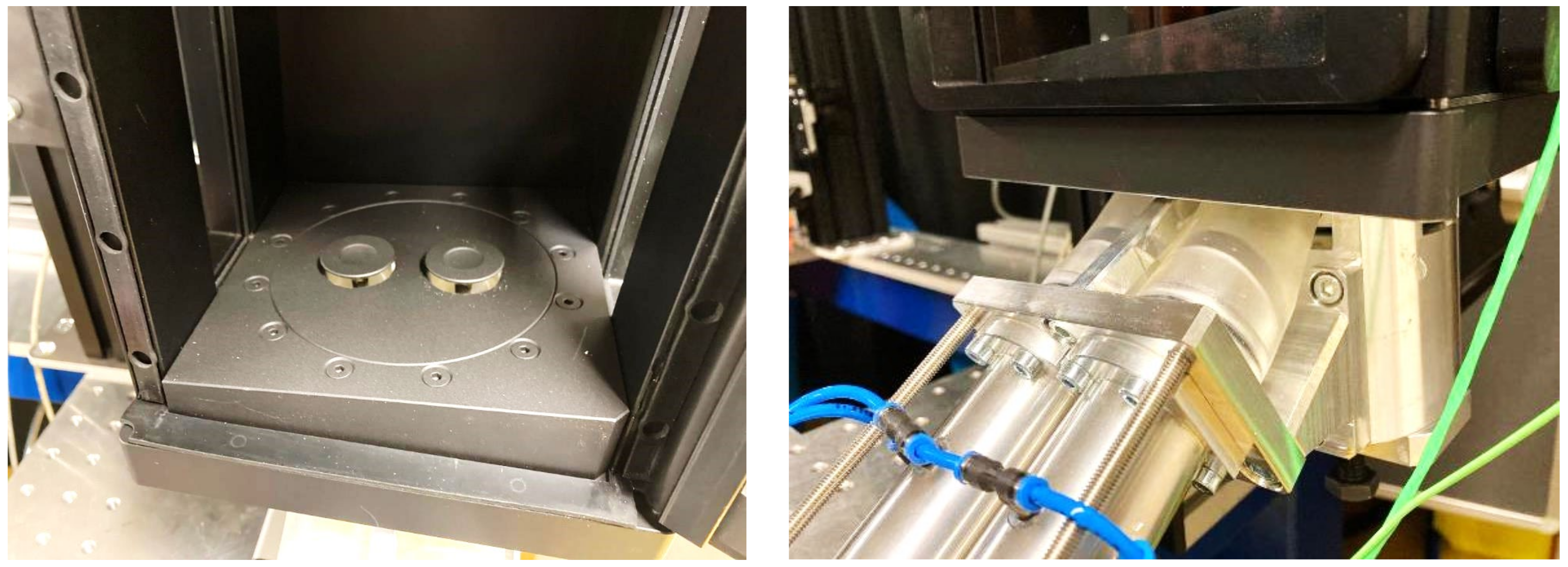
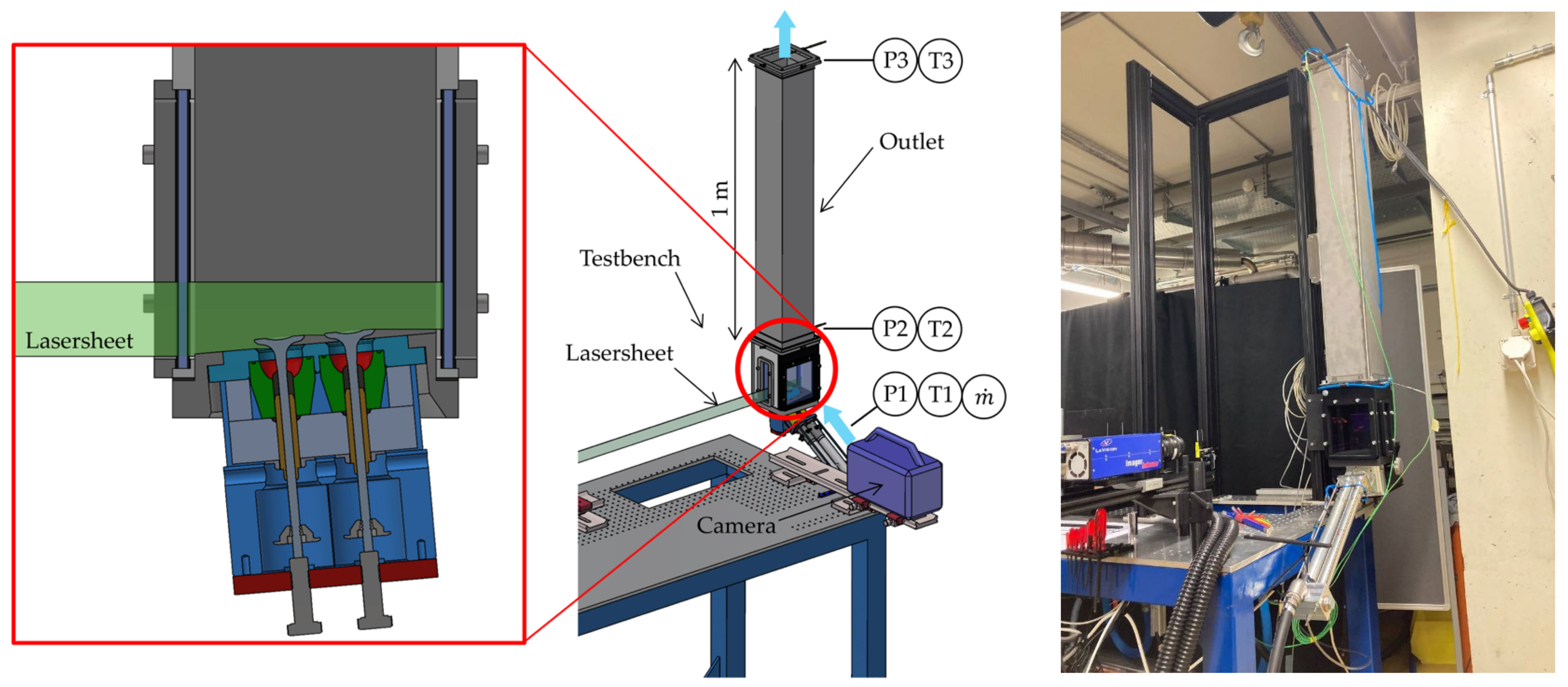



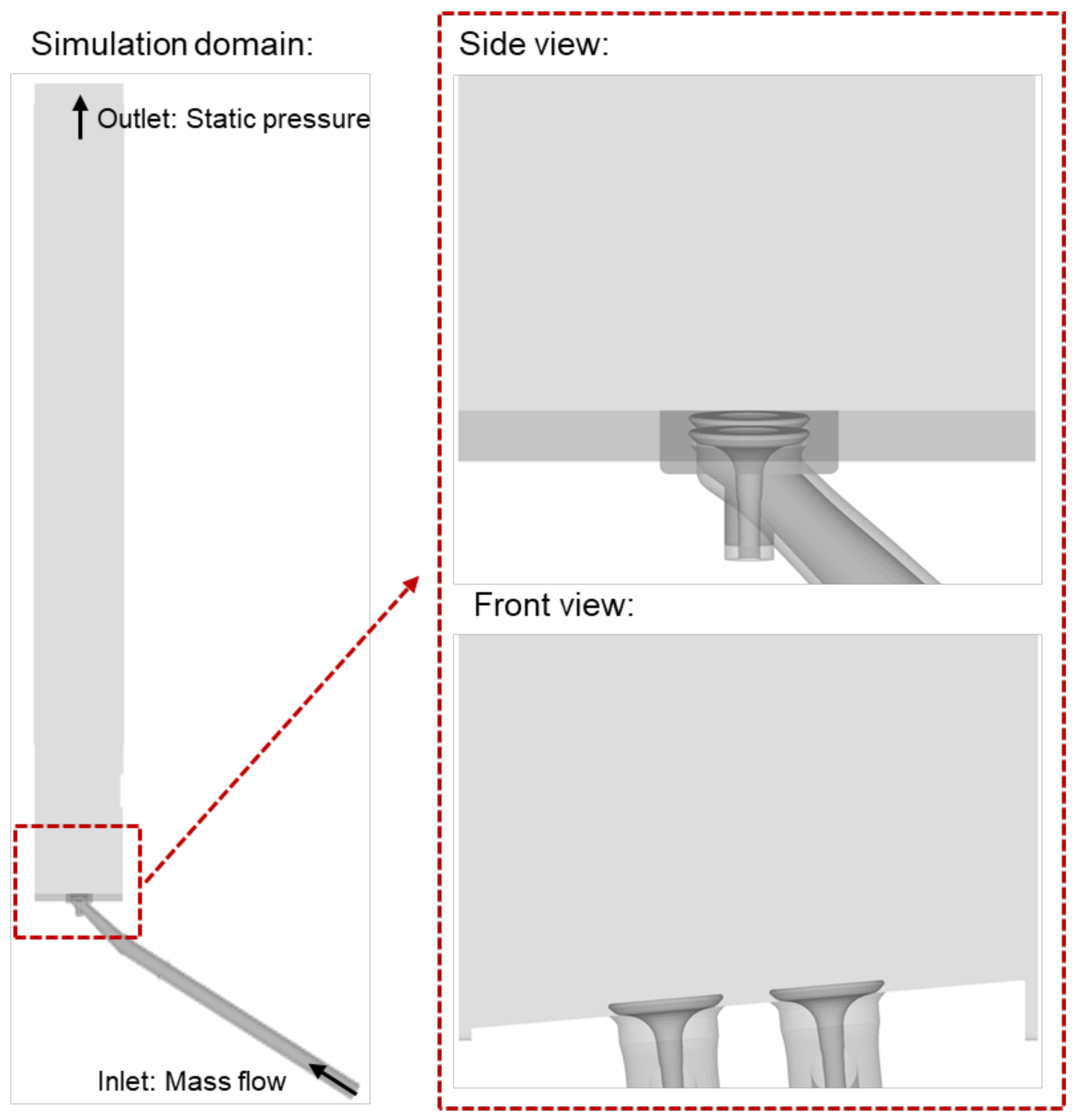
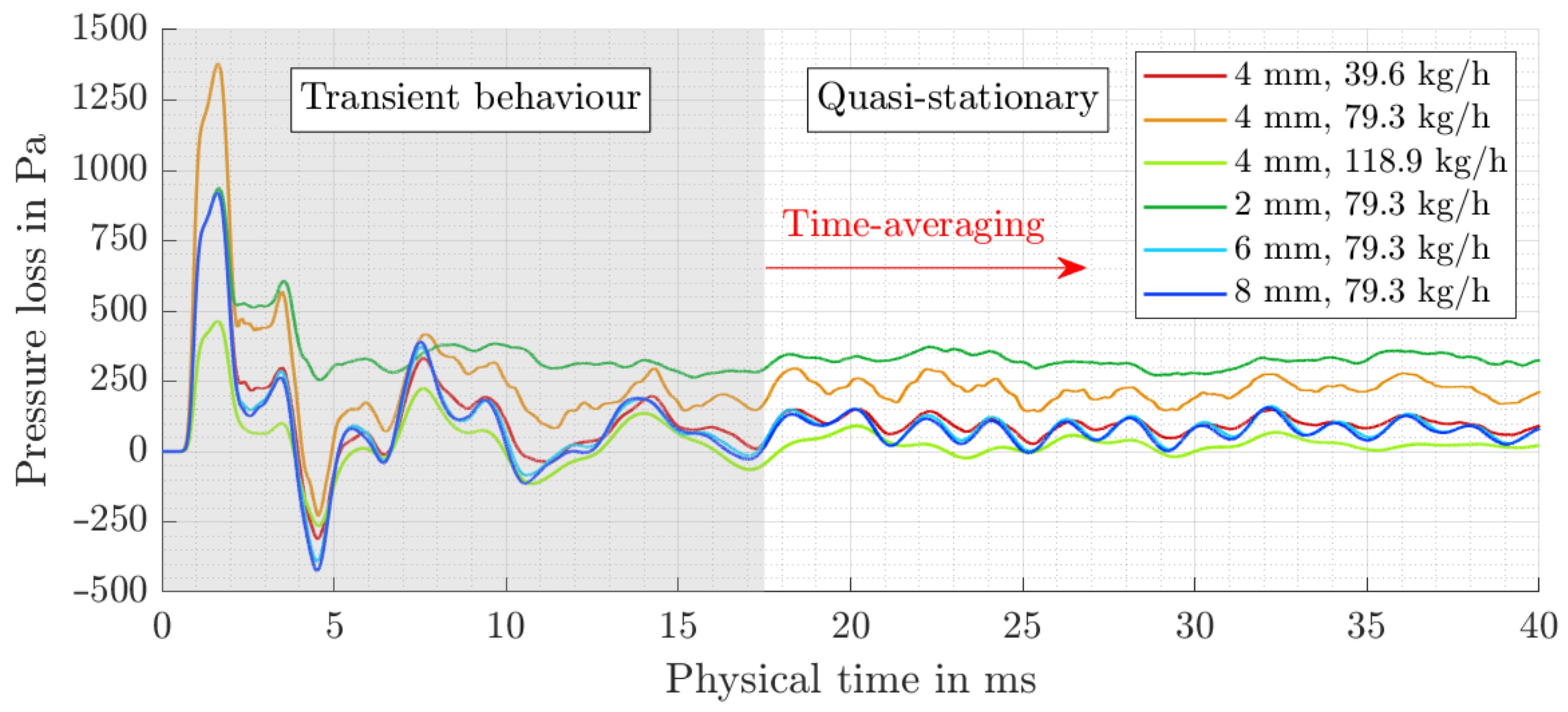

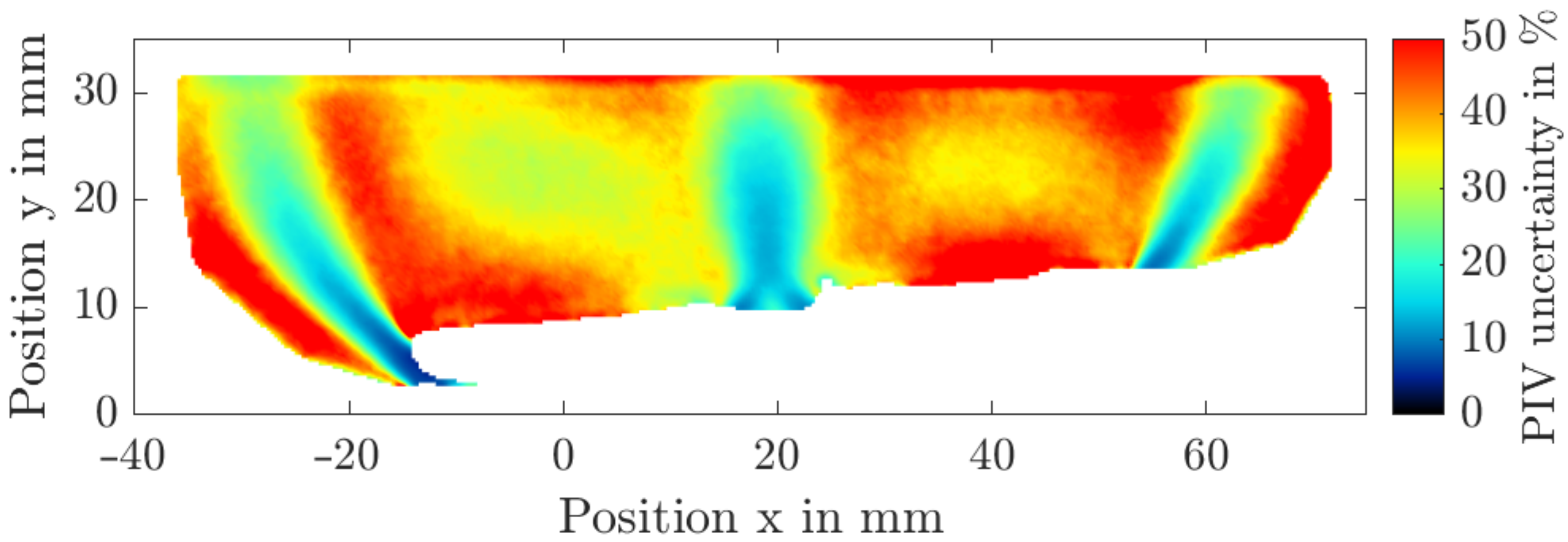
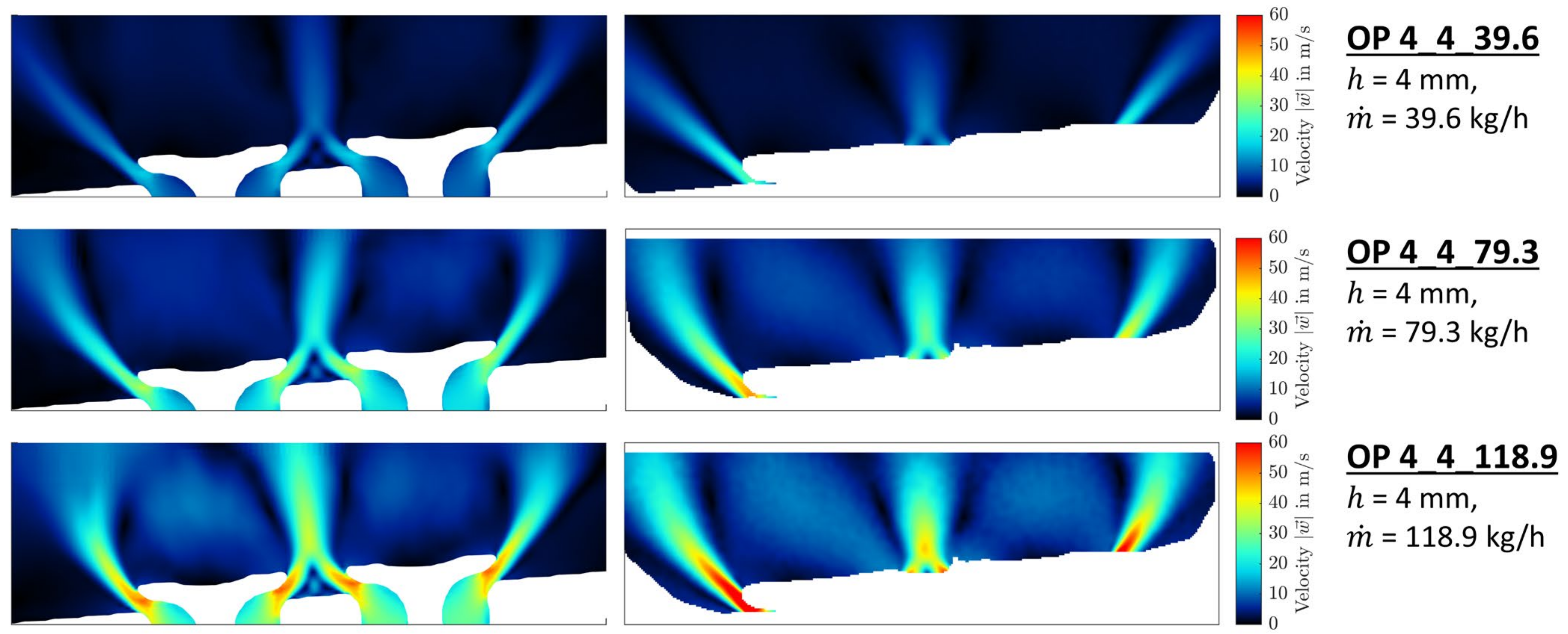

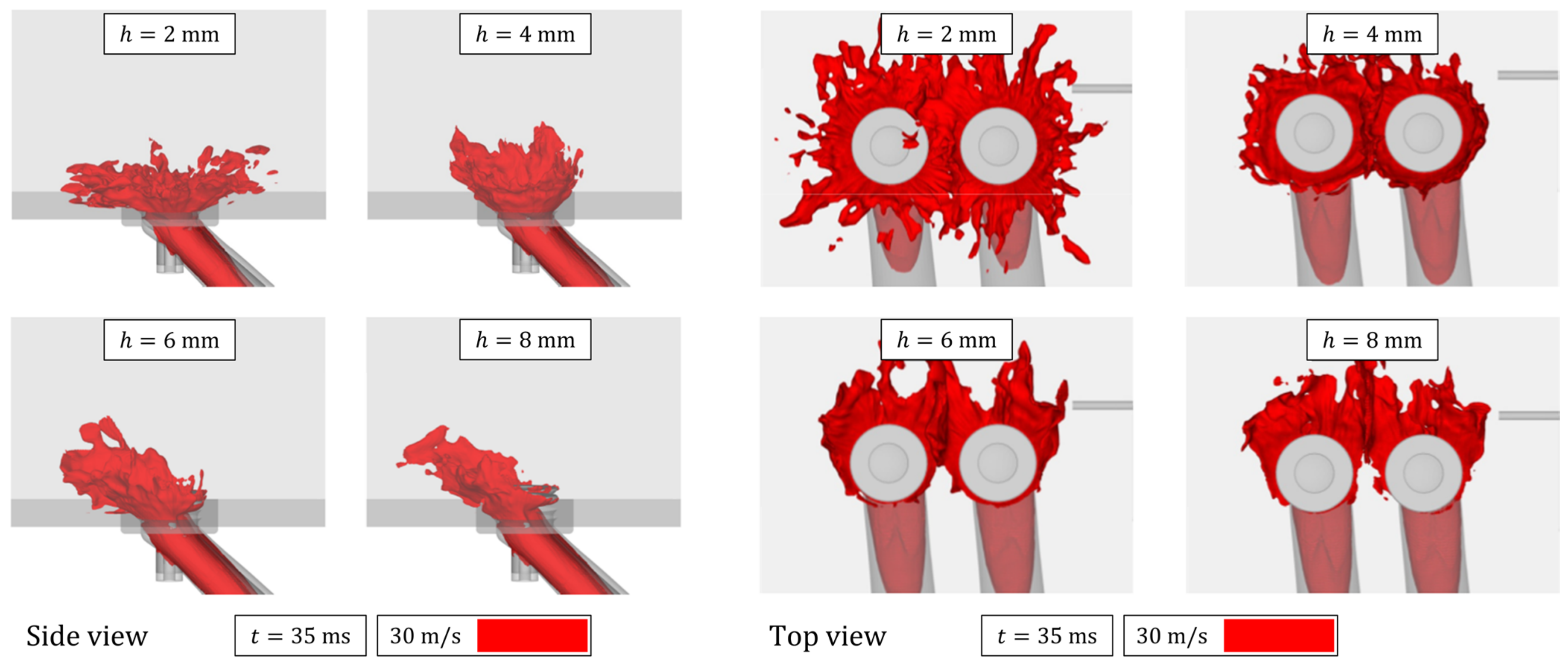
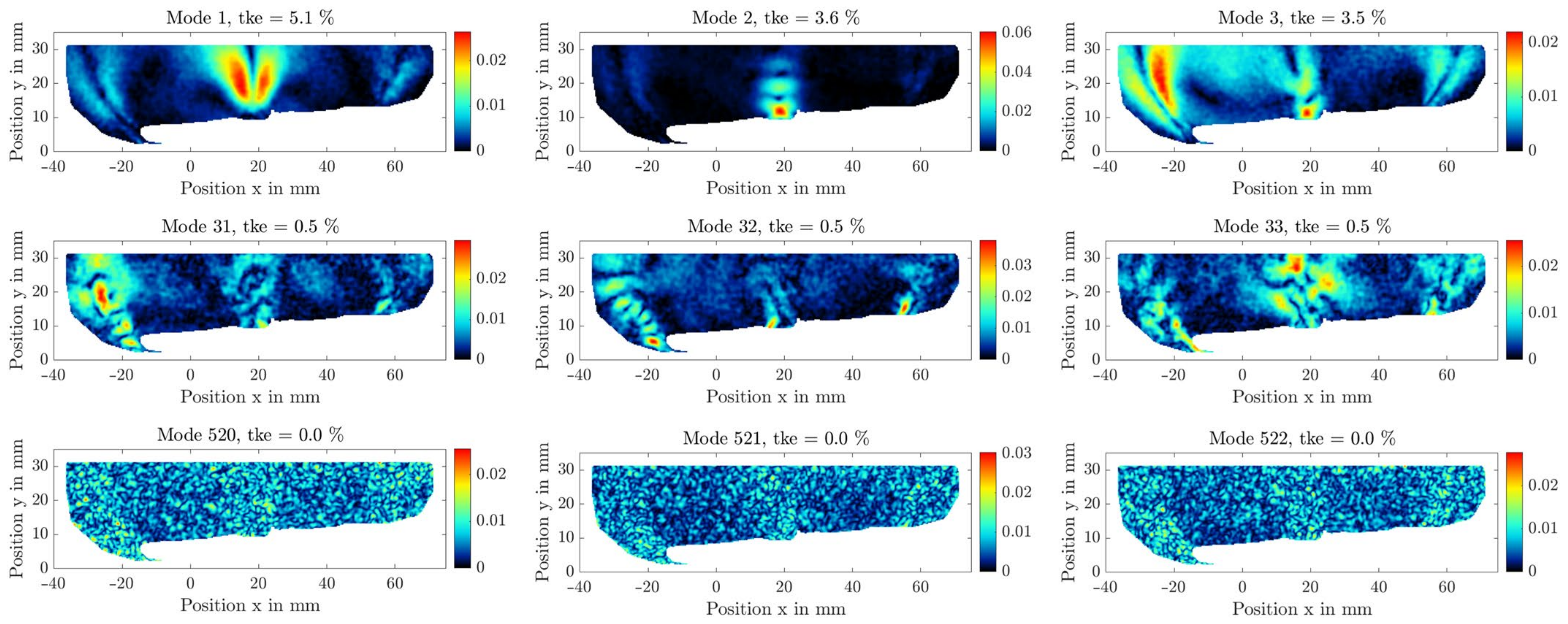

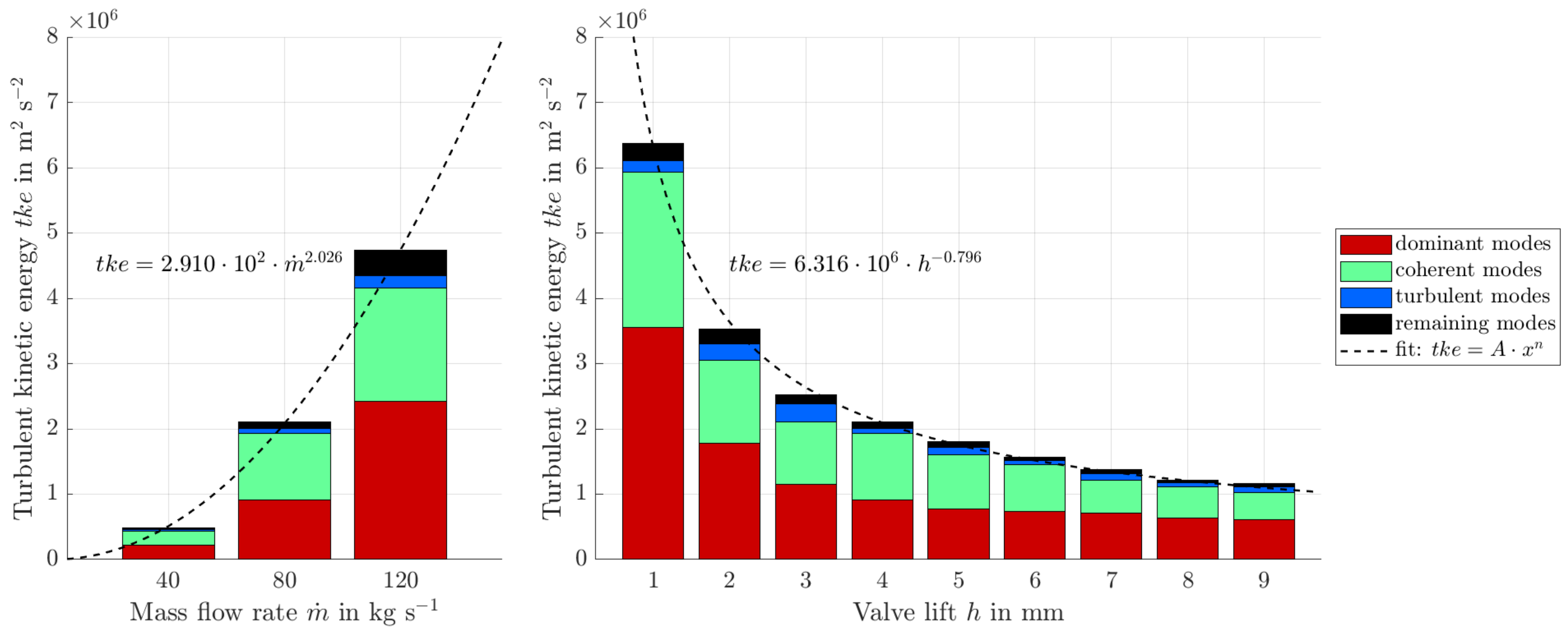


| Description | Value | SI Units |
|---|---|---|
| Compression ratio | 10.8 | - |
| Stroke | 90.5 | mm |
| Bore | 75 | mm |
| Piston displacement | 400 | cm3 |
| Convergence Tolerance | Min. Iterations | Max. Iterations | SOR Relaxation | |
|---|---|---|---|---|
| Momentum | 1 × 10−5 | 0 | 50 | 1.0 |
| Pressure | 1 × 10−8 | 2 | 500 | 1.1 |
| Mass | 1 × 10−4 | 0 | 2 | 1.0 |
| Energy | 1 × 10−4 | 0 | 2 | 1.0 |
Disclaimer/Publisher’s Note: The statements, opinions and data contained in all publications are solely those of the individual author(s) and contributor(s) and not of MDPI and/or the editor(s). MDPI and/or the editor(s) disclaim responsibility for any injury to people or property resulting from any ideas, methods, instructions or products referred to in the content. |
© 2023 by the authors. Licensee MDPI, Basel, Switzerland. This article is an open access article distributed under the terms and conditions of the Creative Commons Attribution (CC BY) license (https://creativecommons.org/licenses/by/4.0/).
Share and Cite
Hoffmann, J.; Vera-Tudela, W.; Mirsch, N.; Wüthrich, D.; Schneider, B.; Günther, M.; Pischinger, S.; Weiss, D.A.; Herrmann, K. Investigation of Flow Fields Emanating from Two Parallel Inlet Valves Using LES, PIV, and POD. Energies 2023, 16, 6917. https://doi.org/10.3390/en16196917
Hoffmann J, Vera-Tudela W, Mirsch N, Wüthrich D, Schneider B, Günther M, Pischinger S, Weiss DA, Herrmann K. Investigation of Flow Fields Emanating from Two Parallel Inlet Valves Using LES, PIV, and POD. Energies. 2023; 16(19):6917. https://doi.org/10.3390/en16196917
Chicago/Turabian StyleHoffmann, Jana, Walter Vera-Tudela, Niklas Mirsch, Dario Wüthrich, Bruno Schneider, Marco Günther, Stefan Pischinger, Daniel A. Weiss, and Kai Herrmann. 2023. "Investigation of Flow Fields Emanating from Two Parallel Inlet Valves Using LES, PIV, and POD" Energies 16, no. 19: 6917. https://doi.org/10.3390/en16196917







